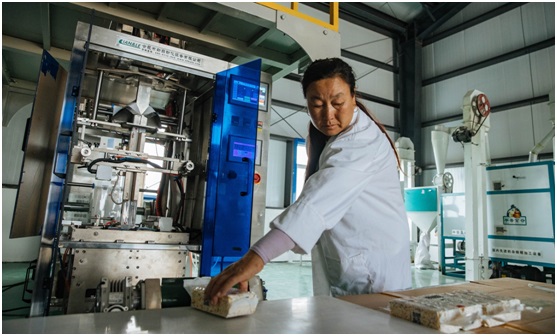



Yuanxin village had suffered poverty for a long time. Located in North China’s Inner Mongolia Autonomous Region, it used to be labeled as a national-level poverty-stricken village.
The ordinary village seemed to have nothing special that could serve its development, such as mines or tourist attractions. But as Yuanxin has become a model of poverty alleviation work, the story of how such a village could escape poverty has been reported across China.
Two years ago, Zhang Hua, graduated with a PhD in agrology from Beijing Forestry University, became the first secretary of the Party committee of the village. Zhang was dispatched by the university to aid Inner Mongolia’s poverty reduction efforts.
The young secretary said he was not trusted by villagers at first, but that he believes that tangible actions could win trust. Zhang led the village to renovate roads that were in poor condition, and prevent insects from damaging crops.
Yuanxin began to develop “black agriculture” – farming black sticky corn. The corn was sold in Beijing with the brand “Yuanxin,” which became very popular. The output value of growing corn tripled.
By the end of 2018, the last 44 people from 21 households had gotten rid of poverty in Yuanxin.
It wasn’t just farmers that benefited from the policy.
Sun Cai, 54, has run a shop in Yuanxin for 20 years. The shop was in a shabby shed before last year when he built a house and transformed his small shop into a supermarket covering 365 square meters. During the epidemic, Sun donated ramen, masks and bottled water to help others in the village.
“Previously, villagers liked to pay on credit, and many times I could not have the money in the end,” Sun told the Global Times. “Now everybody uses cash, because everybody has practical means to make a living.”
Sun is considering building a storage facility to further enlarge his supermarket.
Yuanxin’s success in poverty alleviation is reflective of China’s on-going campaign to eliminate poverty.
Through targeted measures, aid mechanisms, the fostering of e-commerce and tourism industries, relocation, and the dispatching of officials to poverty-stricken villages, China has achieved profound results in reducing poverty and is determined to eradicate absolute poverty this year despite challenges, said officials.
Since the 18th National Congress of the Communist Party of China in late 2012, the country has achieved significant progress in poverty reduction, with over 93 million rural people lifted out of poverty over seven years, Xinhua News Agency reported.
China had basically completed relocation programs for poverty-alleviation purposes by the end of July, the State Council Leading Group Office of Poverty Alleviation and Development said in early August.
Despite the adverse impact caused by COVID-19, China has steadily pushed ahead with efforts to fight poverty in the first half of the year. A total of 2.85 million people in 52 key poverty-stricken counties have returned to work, and 22 provincial-level regions in central and west China have relocated around 4.79 million poor people through creating public welfare jobs, showed data from the office.
Some 428,400 poverty-relief projects in these regions have started operating, and 30,443 poverty-relief workshops have resumed.
Source: Global Times


The Executive and members of the.


The Acting Director, FCT Directorate of.


President Bola Ahmed Tinubu has been.



Barely a month after resignation of.


An Abuja based Legal Practitioner, Osuagwu.



Convener of Equitable Remedy, Mrs. Magaret.


Contractors handling the contract for city.


Nigerian government may have concluded plans.


The Diplomatic Correspondents Association of Nigeria.


A rights group, “Follow Me Talk.
Leave a Comment